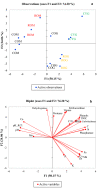Effects of different pioneer and exotic species on the changes of degraded soils
- PMID: 36329111
- PMCID: PMC9633587
- DOI: 10.1038/s41598-022-23265-y
Effects of different pioneer and exotic species on the changes of degraded soils
Abstract
Soil degradation resulting from deforestation contributes to a dramatic decline in soil quality whose restoration must go through reforestation with pioneer species. We investigated the effects of cypress and black locust, pioneer but exotic species, on soil chemical properties and microbial and enzymatic activities of two marginal soils. The sampling sites were Lama Giulia and Locone lake in the Murge plateau of the Apulia Region, Italy. The soils at Lama Giulia presented a silty loam texture, while at Locone Lake site were sandy, and most likely due to the different texture, the former exhibited higher organic C, N, P and micronutrients contents than Locone Lake under black locust reforestation, despite the latter was reforested earlier. In addition, the higher microbial entropy and turnover of Locone Lake's soils suggested a less conservative soil state than Lama Giulia's soils. The effects of black locust reforestation at Lama Giulia on almost all soil parameters considered did not differ from those of the corresponding pasture, confirming the more conservative soil state in that site and suggesting that the time of reforestation was not enough to get differences between the reforested and not reforested soil. The soils reforested with cypress showed the significantly highest SOC, N, dissolved organic C and microbial biomass C content. In addition, it presented also the numerically largest dehydrogenase, phosphatase and β-glucosidase activities, soluble carbohydrates, and phenolic compounds content. These results may be ascribed to the longer litter deposition occurred in cypress soils.
© 2022. The Author(s).
Conflict of interest statement
The authors declare no competing interests.
Figures



References
-
- Sacristán, D., Peñarroya, B., Recatalá, L. Increasing the Knowledge on the Management of Cu-Contaminated Agricultural Soils by Cropping Tomato (SolanumLycopersicum L.). LandDegrad.Dev.26, 587–595 (2015).
-
- FAO. LandDegradationAssessmentinDrylands.ManualforLocalLevelAssessmentofLandDegradationandSustainableLandManagement.Part1:PlanningandMethodologicalApproach,AnalysisandReporting. https://www.fao.org/3/i6362e/i6362e.pdf (Food and Agriculture Organization of the United Nations, 2011).
-
- Misano G, Di Pietro R. Habitat 9250 “Quercus trojana woods” in Italy. Fitosociologia. 2007;44:235–238.
-
- Biondi E, et al. A contribution towards the knowledge of semideciduous and evergreen woods of Apulia (south-eastern Italy) Fitosociologia. 2004;41(1):3–28.
MeSH terms
Substances
LinkOut - more resources
Full Text Sources

